Full project name:
Electron and magnetic properties of R2T2O7 pyrochlores with strong spin-orbit coupling
Project Details
The aim of the project is to contribute to the progressively developing research on the rare-earth pyrochlores R2Ir2O7. The investigation of magnetic structures, magnetic excitations and conductivity, as a result of the antiferromagnetically coupled moments on the geometrically frustrated lattice and interplay between spin-orbit coupling and electron correlations in these compounds, forms the main part of the project. The main focus, besides the macroscopic properties study, is dedicated to a better understanding of the microscopic mechanisms leading to the observed phenomena and their evolution with the rare-earth element. Non-trivial samples synthesis and characterization; magnetization, ac-susceptibility or specific heat measurements; will be corroborated by synchrotron radiation, muon and neutron scattering experiments. Simultaneously, the project aims to establish the problematics of rare-earth pyrochlore oxides within the current fundamental science research on the ground of Charles University.
-
Principal Investigator
Dr. Milan Klicpera -
Team
4 postdocs, 2 students -
Duration
2018 - 2020 -
Research area
stronlgy correlated electron systems

Dr. Milan Klicpera
Principle investigator
Current position: assistant professor at the Department of Condensed Matter Physics, Faculty of Mathematics and Physics, Charles University.
Main field: magnetism in condensed matter, energy excitations, low temperature physics
Fields of interest and expertise: condensed matter physics, macroscopic and microscopic properties of rare-earth-based intermetallic compounds, preparation of polycrystalline and single crystalline samples, magnetic structures and crystal field excitations, neutron scattering techniques.
Role of MGML in the Project
MGML instruments are to be employed for all samples synthesis, characterization by x-ray diffraction and EDX, measurement of bulk physical properties down to lowest temperatures.

